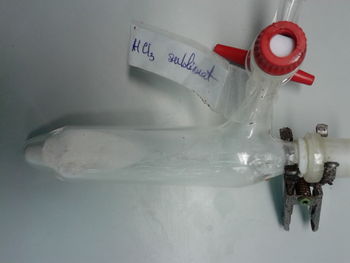Schlenk flask
 |
This article is a stub. Please help Sciencemadness Wiki by expanding it, adding pictures, and improving existing text.
|

A Schlenk flask (also called Schlenk tube or nitrogen round-bottom flask) is a reaction vessel often used in air-sensitive chemistry or for storing sensitive chemicals, either hygroscopic or air-sensitive. These flasks are often connected to Schlenk lines, and are important in air-free synthesis and other procedures that require inert gases.
Contents
Design
Schlenk flasks appear as ground-joint round bottom flasks, which have a side arm fitted with a ground glass or (rarer) PTFE stopcock, which allows the vessel to be evacuated or filled with gases (usually inert gases like nitrogen or argon).
Types of Schlenk flasks
Standard Schlenk flask
The standard Schlenk flask is a round bottom, pear-shaped, or tubular flask with a ground glass joint and a side arm. The side arm contains a valve, most often a greased stopcock, with PTFE stopcocks being more rare. The stopcock is used to control the flask's exposure to a manifold or the atmosphere. Addition of reagent/stir bar to the flask is done through the ground glass joint. If the reagent added is air-sensitive, a septum is used to cap the flask, while the reagent is added as solution with a syringe.
Schlenk bomb
A subclass of the standard Schlenk flask, it contains only one ground glass joint present on the side of the flask, accessed by opening a Teflon plug valve. This design allows the Schlenk bomb to be sealed more completely than the standard Schlenk flask, even if its septum or glass cap is wired on. Schlenk bombs are often used to conduct reactions at elevated pressures and temperatures as a closed system.
Straus flask
Commonly used for storing dried and degassed solvents, Straus flasks differ than normal Schlenk flasks by having the two flask necks joined through a glass tube.
Solvent pot
The most common configuration of a solvent pot is a simple round bottom flask attached to a 180° adapter fitted with some form of valve. The pot can be attached to a manifold and the contents distilled or vacuum transferred to other flasks free of soluble drying agents, water, oxygen or nitrogen. The term "solvent pot" can also refer to the flask containing the drying agents in a classic solvent still system.
Uses
Schlenk flasks are used for performing simple air-sensitive reactions. Tubular Schlenk flasks are tend to be used for storing air and moisture sensitive reagents, with the tubular flasks being more commonly employed, especially for solid powders.
Maintenance
Since they are often used to create vacuum, they should be inspected periodically for any cracks.
Schlenk flasks aren't cheap, so it's best to take good care of them.
When using them, always hold them in a vertical position. Cork rings or utility clamps are best suited for this task.